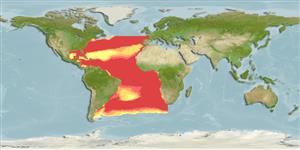Common names from other countries
>
Scombriformes (Mackerels) >
Bramidae (Pomfrets)
Etymology: Taractichthys: Greek, taraktes = confusion; for the pletora of names that have been applied to this fish + Greek, ichthys = fish (Ref. 45335); longipinnis: longipinnis meaning long-finned (Ref. 4525).
More on author: Lowe.
Environment: milieu / climate zone / depth range / distribution range
Ecologia
marino; oceanodromo (Ref. 51243); distribuzione batimetrica 0 - 500 m (Ref. 89422), usually 42 - 200 m (Ref. 82736). Subtropical; 10°C - ? (Ref. 82736); 47°N - 68°S, 98°W - 21°E
Eastern Atlantic: Iceland and Norway southward to off Pointe Noire, Gulf of Guinea and Namibia; questionably reaching False Bay, South Africa (Ref. 4388). Absent from the Mediterranean (Ref. 4936). Western Atlantic: Nova Scotia, Canada and northern Gulf of Mexico to Puerto Rico (Ref. 7251), Bermuda, northern South America to southeastern Brazil (Ref. 82736). Highly migratory species.
Size / Peso / Age
Maturity: Lm ? range ? - ? cm
Max length : 100.0 cm SL maschio/sesso non determinato; (Ref. 6697)
Spine dorsali (totale): 0; Raggi dorsali molli (totale): 33-38; Spine anali 0; Raggi anali molli: 27 - 30. Grey or silvery in color, with coppery reflections (Ref. 4388).
Generally oceanic and presumably epipelagic. Often solitary but occasionally found in small schools close to shore (Ref. 82736). Feed on shrimps and squids (Ref. 82736). Young are present in all seasons (Ref. 6697). Flesh considered very good (Ref. 3576).
Life cycle and mating behavior
Maturità | Riproduzione | Deposizione | Uova | Fecundity | Larve
Gomes, J., 1990. Bramidae. p. 758-764. In J.C. Quero, J.C. Hureau, C. Karrer, A. Post and L. Saldanha (eds.) Check-list of the fishes of the eastern tropical Atlantic (CLOFETA). JNCT, Lisbon; SEI, Paris; and UNESCO, Paris. Vol. 2. (Ref. 4936)
IUCN Red List Status (Ref. 130435)
CITES (Ref. 128078)
Not Evaluated
Threat to humans
Harmless
Human uses
Pesca: scarso interesse commerciale
Informazioni ulteriori
Nomi ComuniSinonimiMetabolismoPredatoriEcotossicologiaRiproduzioneMaturitàDeposizioneFecundityUovaEgg development
BibliografiaAcquacolturaProfilo di acquacolturaVarietàGeneticaElectrophoresesEreditarietàMalattieElaborazioneMass conversion
CollaboratoriImmaginiStamps, Coins Misc.SuoniCiguateraVelocitàModalità di nuotoArea branchialeOtolithsCervelliVista
Strumenti
Special reports
Download XML
Fonti Internet
Estimates based on models
Preferred temperature (Ref.
115969): 8 - 26.3, mean 17.6 (based on 589 cells).
Phylogenetic diversity index (Ref.
82804): PD
50 = 0.7500 [Uniqueness, from 0.5 = low to 2.0 = high].
Bayesian length-weight: a=0.01820 (0.00782 - 0.04232), b=2.96 (2.76 - 3.16), in cm Total Length, based on LWR estimates for this (Sub)family-body shape (Ref.
93245).
Trophic level (Ref.
69278): 4.5 ±0.62 se; based on food items.
Resilienza (Ref.
120179): Molto basso, tempo minimo di raddoppiamento della popolazione più di 14 anni (Preliminary K or Fecundity.).
Fishing Vulnerability (Ref.
59153): High to very high vulnerability (73 of 100).
